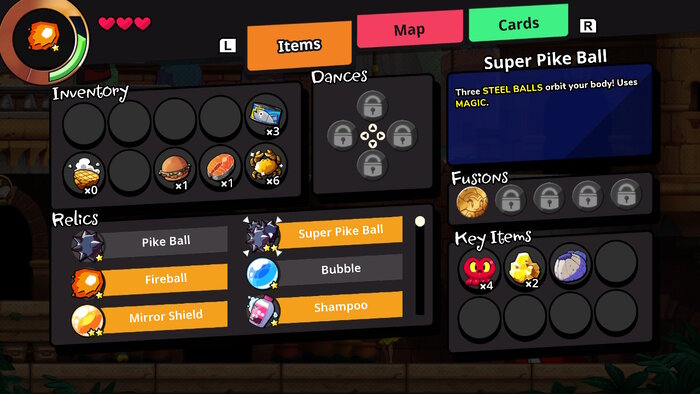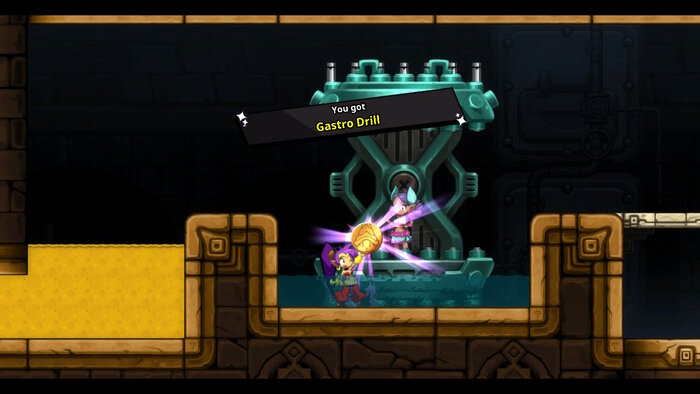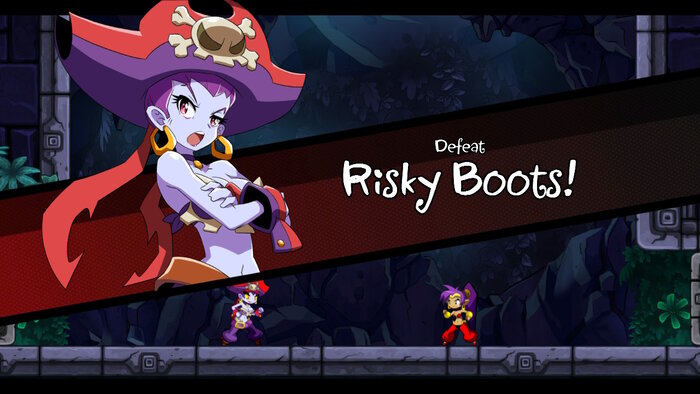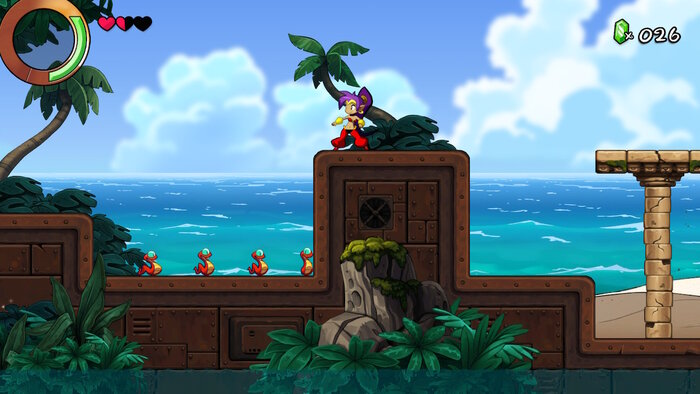
A nice vacation getaway isn’t the only thing you get when you play through Shantae and the Seven Sirens. The 5th game in the acclaimed 2D Platformer Series sees Shantae’s vacation go horribly wrong and tasking her to save Paradise Island from an unknown menace. Taking the visual art style from the last game and bringing it back to its more Metroidvania style roots while also introducing new mechanics makes this game feel both fresh and nostalgic at the same time.
The story of Shantae and the Seven Sirens is a simple premise, but it works for what the game sets up. Shantae and her friends are taking a vacation to paradise island, where Shantae is invited as a guest alongside other Half Genies such as herself. However, things aren’t as they seem as all the girls are quickly kidnapped. Shantae takes it upon herself to uncover the secrets of the island and find the lost girls.
In Shantae and the Seven Sirens, you must navigate across the cohesive world known as Paradise Island consisting of multiple towns, caves, and labyrinths. Each Town has its own group of people, featuring shops, save points, and warp points to travel throughout the island. At first, you’re only allowed to Jump and Hair Whip as your main form of attack, but by exploring the island, you will find different collectibles that can be traded in for different weapons and upgrades. Because the world is interconnected, it feels like you’re exploring 1 place that geographically makes sense and it shows your sense of progression when you explore new areas of the map.
The people you meet will often give you fetch quests or require that you visit places to find the labyrinth of the area, which is underground. While every labyrinth is unique, they are all crawling with enemies and puzzles for Shantae to overcome. Some puzzles are room-based while others require the use of certain dances to complete, helping to personalize each dungeon. Save points and warp rooms can be found in case you need to resupply on items, and the labyrinth ends with a boss battle, usually against one of the sirens.
Shantae and the Seven Sirens increases the number of collectibles to find throughout Paradise Island. Not only do you have staples of the series like Heart Squids to trade for hearts, Seven Sirens includes a new item called Monster Cards. These cards are dropped after killing the specific monster type, and not only does gaining a certain amount of them net you a rare ability, certain townsfolk will have a rare one that you need to buy with nuggets, hidden in chests on the island.

While looking at the sleek interface, you may notice that even early in the game, you have enough food and items to make it through tough battles.
You can also buy magic upgrades from the shop using gems. From rotating spike balls to increasing the speed of your hair whip, most of the upgrades are useful for making late-game easier. The various tiers of magic and defensive options allow for different playstyles, even though most bosses don’t require you to change the flow of how you do things drastically. However, it feels like the loot drops in-game are often too frequent. The amount of gems you get from monsters is often more than needed to buy a lot of upgrades in one go.
The Shantae series is not known for high difficult, but Seven Sirens is undoubtedly the easiest in the series. Most enemies drop superfluous amounts of Heart pickups and food items which make it very hard to die or game over if you play your cards right. Along with that, they also drop plenty of gems that make getting good upgrades easy early in the game. You get access to a healing spell that can be used infinitely, which is often unneeded considering it’s not tough to die. These things, taken with the Bosses not being difficult, make Seven Sirens become a sort of a slog near the end of the game.
Shantae’s main specialty is her dances. Pressing X will give you the choice of dances that are unlocked during the main story. Each one takes a part of the magic meter, but using it can range from making invisible platforms visible to shocking objects with electricity. While not every dance is usable in combat, most of them have a use in specific dungeons, allowing you to get rid of a certain enemy type or heal a plant object in the background to gather more gems and other rewards.

In every dungeon, you save one of the missing half genies who help you by giving you a fusion coin, allowing you to traverse new areas.
New to Seven Sirens is “Fusion Dances”, which take the place of the dances from past series. By pressing a specific button, you get more robust movement options such as an air dash, a wall climb, and a drill to dig through sand. These Fusion Dances are built into the game and don’t require magic, whereas the standard dances require a portion of the Magic Meter to activate. This adds to exploration as certain areas will be locked off until you get a new ability, allowing you to come back for goodies and other treasures.
Seven Sirens combines the Metroidvania style of the series while also trying to implement the more platforming based sections of Shantae: Half Genie Hero, the previous game in the franchise. While on paper this sounds good, the game often feels formulaic the more you progress through the game. Most of the time you go to a new area, talk to people until you find the labyrinth, enter and defeat the boss, gaining a new power-up along the way. There aren’t any special mini-games or events to break up the formula, which makes the game often feel basic.

Risky Boots picks a fight with Shantae over 4 times total during the game, and each boss-fight has almost the exact same patterns making it feel like a rehash.
Even though Shantae is shown to have traveled with her friends and the debs go to the length of introducing new Half Genies, often they don’t show up in gameplay. Characters like Bolo and Sky are loved by fans and do very little in this game. Rottytops and Mimic do help Shantae in the adventure, but it still feels like Shantae is on her own for a majority of the game. This feeling permeates with the half genies, who are in the beginning for 1 to 2 encounters until they are kidnapped and barely come into play until near the end of the game, only giving Shantae access to their powers in between.
Shantae and the Seven Sirens reuses a lot of assets from previous entries of the series, but this isn’t a problem. The brightly colored sprites and bubbly animations make looking at the flush, detailed environments a delight. The music also follows the same idea. The mix of pop music and nostalgic chip-tune go together well and suit the tone of the game.

The presentation of each level is outstanding. This level has lush greenery and strikingly blue oceans that go together with the bubbly pop music of the level.
Shantae and the Seven Sirens aimed to combine old elements of the franchise with new ones, and in the end, it succeeded, but not without its slip-ups. The return to Metroidvania and the number of items you can collect make it fun to go back to and explore, but its monotony and easy difficulty don’t make long play sessions enjoyable. If you take the game at face value and enjoy the charm-filled scenes that make Shantae so lovable, then the game becomes more endearing to go through.
Shantae and the Seven Sirens receives a 7.5 out of 10.